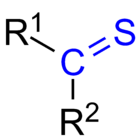Thioketone

Thioketones (also known as thiones or thiocarbonyls) are organosulfur compounds related to conventional ketones. Instead of the formula R2C=O, thioketones have the formula R2C=S, which is reflected by the prefix "thio-" in the name of the functional group. Unhindered alkylthioketones typically tend to form polymers or rings.[1]
Preparative methods
Thiones are usually prepared from ketones using reagents that exchange S and O atoms. A common reagent is phosphorus pentasulfide[2] and the related reagent Lawesson's reagent. Other methods uses a mixture of hydrogen chloride combined with hydrogen sulfide. Bis(trimethylsilyl)sulfide has also been employed.[1][3]
Thiobenzophenone ((C6H5)2CS) is a stable deep blue compound that dissolves readily in organic solvents. It photooxidizes in air to benzophenone and sulfur. Since its discovery, a variety of related thiones have been prepared.[4]
Thiosulfines
Thiosulfines, also called thiocarbonyl S-sulfides, are compounds with the formula R2CSS. Although superficially appearing to be cumulenes, with the linkage R2C=S=S, they are more usefully classified as 1,3-dipoles and indeed participate in 1,3-dipolar cycloadditions. Thiosulfines are proposed to exist in equilibrium with dithiiranes, three-membered CS2 rings. Thiosulfines are often invoked as intermediates in mechanistic discussions of the chemistry of thiones. For example, thiobenzophenone decomposes upon oxidation to the 1,2,4-trithiolane (Ph2C)2S3, which arises via the cycloaddition of Ph2CSS to its parent Ph2CS.[5]
Selenones
Selenketones and tellurones the selenium and tellurium versions of the thioketones, are more reactive. They require greater steric and electronic stabilization.[1][4] Selenobenzophenone reversibly dimerizes. It is known to undergo cycloaddition with 1,3-dienes in a reaction similar to the Diels-Alder reaction.[6]
See also
- Thial, for a description of thioaldehydes.
- Thioketene
- Thioacetone
References
- 1 2 3 Kuhn,, N.; Verani,, G. (2007). "Chalcogenone C=E compounds". Handbook of Chalcogen Chemistry: New Perspectives in Sulfur, Selenium and Tellurium. Royal Society of Chemistry. doi:10.1039/9781847557575-00107.
- ↑ Polshettiwar, Vivek; Kaushik, M. P. (2004). "A new, efficient and simple method for the thionation of ketones to thioketones using P4S10/Al2O3". Tetrahedron Letters. 45: 6255–6257. doi:10.1016/j.tetlet.2004.06.091.
- ↑ Mcgregor, W. M.; Sherrington, D. C. (1993). "Some recent synthetic routes to thioketones and thioaldehydes". Chemical Society Reviews. 22 (3): 199. doi:10.1039/CS9932200199.
- 1 2 Okazaki, R.; Tokitoh, N. (2000). "Heavy ketones, the heavier element congeners of a ketone". Accounts of Chemical Research. 33 (9): 625–630. doi:10.1021/ar980073b. PMID 10995200.
- ↑ Huisgen, R.; Rapp,, J. (1997). "1,3-Dipolar Cycloadditions. 98. The Chemistry of Thiocarbonyl S-Sulfides". Tetrahedron. 53: 939–960. doi:10.1016/S0040-4020(96)01068-X.
- ↑ Erker, G.; Hock, R.; Krüger, C.; Werner, S.; Klärner, F. G.; Artschwager-Perl, U. (1990). "Synthesis and Cycloadditions of Monomeric Selenobenzophenone". Angewandte Chemie International Edition in English. 29 (9): 1067. doi:10.1002/anie.199010671.
External links and further reading
- Definition of Thioketones in the IUPAC Gold Book
- Definition of Selones in the IUPAC Gold Book
- Kroto, H.; Landsberg, B. M.; Suffolk, R. J.; Vodden, A. (1974). "The photoelectron and microwave spectra of the unstable species thioacetaldehyde, CH3CHS, and thioacetone, (CH3)2CS". Chemical Physics Letters. 29 (2): 265–269. Bibcode:1974CPL....29..265K. doi:10.1016/0009-2614(74)85029-3.